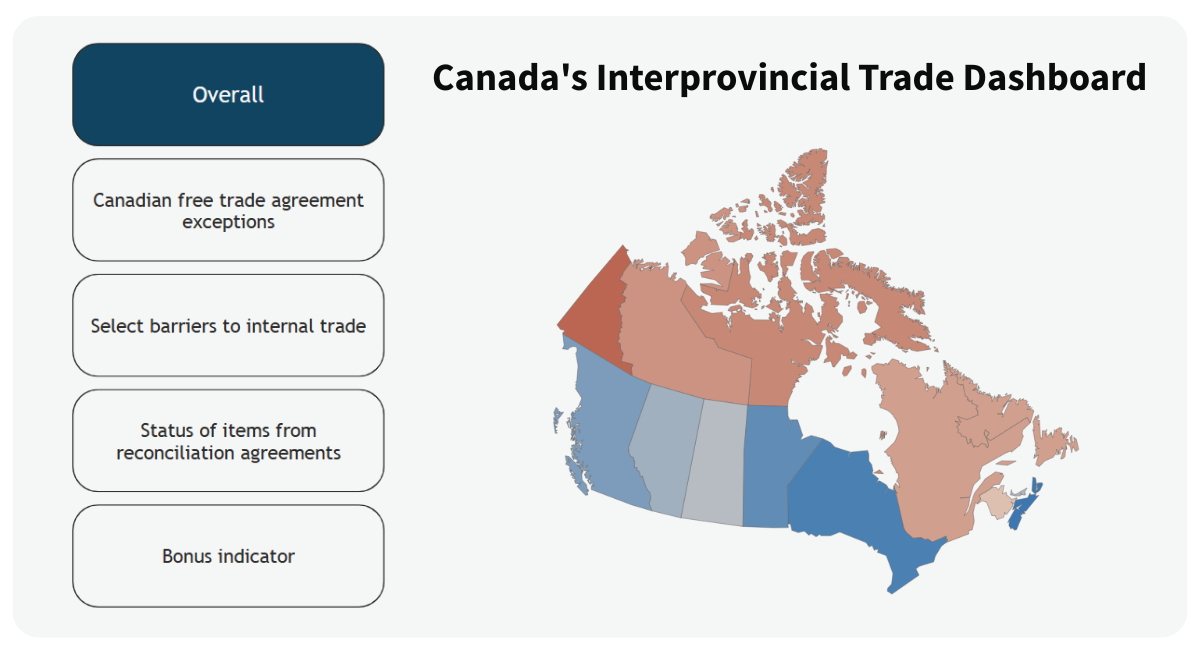Internal Trade & Interprovincial Cooperation
After years of CFIB advocacy, the Canadian Free Trade Agreement (CFTA) was signed July 1, 2017, by all provinces, territories and the federal government. The CFTA replaced the dated and ineffective Agreement on Internal Trade. The purpose of the new agreement is to reduce and eliminate barriers to the free movement of people, goods, services and investments within the country.
Canada's Interprovincial Trade Dashboard
See your government’s grades over the years
Explore our interactive dashboard to see how your government measures up in reducing internal trade barriers across Canada.

Research Report
The State of Internal Trade: Canada’s Interprovincial Cooperation Report Card – 2025
Every year, CFIB evaluates how well federal, provincial, and territorial governments are doing when it comes to removing internal trade barriers that block Canadian businesses from growing across the country.
This year’s report card shows more momentum than we’ve seen in years. Many jurisdictions saw their grades improve, thanks to new legislation, pilot projects, and public commitments to reduce internal trade barriers and recognize credentials across provincial borders.
However, from duplicative regulations to slow approval timelines, many barriers still remain. CFIB’s latest report card highlights these remaining issues, and the work still needed to reach true internal free trade.
This year’s report card continues to grade governments in three areas, with the addition of a new bonus indicator on progress toward mutual recognition:
- Exceptions to the CFTA
- Select barriers to internal trade
- Implementation status of reconciliation agreements
- *New – Bonus indicator: Current status of mutual recognition agreement

How much progress has been made on internal trade?

Pictured: Laura Jones, CFIB’s Executive Vice-President presents Canada’s trade ministers the Golden Scissors Award for the signing of the new Canada Free Trade Agreement (CFTA) in July 2017.
After the Canadia Free Trade Agreement (CFTA) was signed in 2017, progress to reduce and eliminate remaining internal trade barriers was slow, with limited political will to drive meaningful change.
However, in the wake of shifting global dynamics following a change in U.S. political leadership in 2025, and a more challenging bilateral trade relationship as a result, Canadian political leaders have shown renewed interest in improving internal trade. Several governments have made monumental progress over the past year towards reducing domestic trade barriers – an encouraging step for Canada’s economy.
- Canada is entering a new era of internal trade. In February 2025, Nova Scotia led the country by introducing Bill 36: Free Trade and Mobility within Canada Act, committing to mutual recognition of goods (including food), services, and investments with other jurisdictions that pass similar laws. The bill sparked a wave of action with PEI, BC, Ontario, Manitoba, Quebec, the federal government, New Brunswick, and Saskatchewan following suit to announce their own legislations.
- In April 2025, the Ontario government announced the Protect Ontario through Free Trade within Canada Act, and removed all of its party-specific exceptions – the biggest advancement any government took.
- In June 2025, following Ontario, the federal government removed all of its remaining party-specific exceptions.
- In September 2024, the Committee on Internal Trade (CIT) launched a pilot project to mutually recognize regulatory requirements in the trucking sector, with all jurisdictions committing to recognize one another’s regulations while maintaining safety and security. As of June 2025, the First Ministers committed to work together and expand this pilot program.
- In November 2025, the CIT announced that all federal, provincial, and territorial governments signed onto the pan-Canadian Mutual Recognition Agreement on goods. By June 2026, all goods—except food and alcohol—approved for sale in one jurisdiction can be sold in any other Canadian jurisdiction without additional testing, paperwork, or extra fees. The agreement covers thousands of products, including toys, clothing, industrial goods, and vehicles.
We applaud the progress made by governments across the country to advance domestic free trade. However, implementation of the agreement will be a key measurement as to the success of the agreement. CFIB will continue to monitor the progress to hold governments accountable and evaluate whether these policies are making a difference on the ground for Canadian businesses. CFIB will continue to advocate for food, alcohol, services and labour to be included as part of the Canadian Mutual Recognition Agreement.
Breaking Down Barriers
Progress on Labour Mobility
Labour mobility remains a sticking point in many internal trade discussions, with Canadian workers still facing barriers when moving between provinces/territories. However, recent steps have shown slow but meaningful progress.
At the 2025 First Ministers’ meeting in Saskatoon, Canada’s Premiers and the Prime Minister committed to implement a 30-day service standard for recognizing credentials across provinces and territories.
In 2024, Ontario introduced its “As of Right” legislation, permitting specific Canadian-credentialed health care professionals to begin practising immediately in the province for up to six months while their application is completed and approved.
The Atlantic governments were awarded Golden Scissors in 2024 for the launch of the Atlantic Physician Registry. This registry
- Allows physicians registered in one of the four Atlantic provinces to practice in the others as of right.
- Replaces all fees associated with temporary or locum licences for each of the Atlantic provinces with an annual fee of $500.
In 2023, the government of Nova Scotia introduced the Patients Access to Care Act – a portable registration model for health care professionals in Canada. The new Act
- Waives all licensing or registration criteria for healthcare providers coming from other parts of Canada
- Ensures regulators cannot charge an application fee to healthcare professionals licensed in other parts of Canada
- Ensures healthcare providers’ applications are to be processed within five business days
To learn more about CFIB’s recommendations for improving labour mobility across Canada, read our full report below.
Advocacy on Internal Trade
Letters & Submissions
- May 2025 – Letter to PM and Premiers: CFIB letter to PM & Premiers ahead of First Ministers’ Meeting
- July 2024 – Letter to Premiers: Mutual recognition remains best path forward to address remaining barriers
- September 2023 – CFIB Submission to Regulatory Reconciliation and Cooperation Table (RCT) Work Plan for 2023-2024 (In English only)
- August 2022 – CFIB Submission to Regulatory Reconciliation and Cooperation Table (RCT) Work Plan for 2022-2023
- May 2022 – Letter to Premiers: Now is the time to prioritize eliminating internal trade and labour mobility barriers
- April 2021 – Submission to RCT Workplan for 2021-2022
- June 2017 – Letter to Prime Minister Trudeau: Moving Forward to Eliminate Red Tape through the Canadian Free Trade Agreement’s Regulatory Reconciliation and Cooperation Table
Op-Eds
Now isn’t the time for backsliding on internal trade (May 2025)
Nova Scotia leads the way on internal trade (March 2025)
United we should stand. Tear down those trade barriers, premiers! (July 2024)
Canada, take down those walls between interprovincial trade (July 2023)
Premiers need to reaffirm commitment to interprovincial free trade (July 2019)
Alberta's bold move a first step toward free trade in Canada (July 2019)
How Canada's small businesses survived 150 years and more: CFIB (June 2017)
Canada needs its own internal free trade agreement (June 2015)
Recent Media Releases
- All
- Media Releases
About CFIB
The Canadian Federation of Independent Business (CFIB) is the country’s champion of small business. With over 100,000 members, we’re Canada’s largest non-profit organization devoted to creating and supporting an environment where your business can succeed.
Across Canada, we advocate for small business with politicians and decision-makers. As a non-partisan organization, we influence public policy based on our members’ views, ensuring that you have a chance to affect the laws and policies that affect your business.




